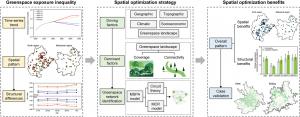Reducing greenspace exposure gaps in China: A new approach to urban equity
GA, UNITED STATES, November 27, 2025 /EINPresswire.com/ -- Urban greenspaces play a crucial role in enhancing well-being by providing essential ecosystem services like cooling and recreation. However, disparities in greenspace exposure are increasing in Chinese cities, threatening equitable access. This study reveals that from 2000 to 2020, greenspace exposure inequality rose by 25% across 246 cities and is projected to increase by up to 15.7% by 2050 under a rapid development scenario (i.e., fossil-fueled scenario), particularly impacting vulnerable populations such as the elderly, women, and megacity residents. By employing a network optimization strategy that enhances patch connectivity, this study shows that inequalities can be mitigated by up to 20.8%, without needing to expand total greenspace, offering a sustainable path to urban resilience and environmental justice.
Greenspaces provide essential services like cooling, air purification, and recreation, critical for the human health and residential well-being. In rapidly urbanizing regions like China, disparities in greenspace access exacerbate social inequalities. These disparities are driven by various factors, including geographic, climatic, and socioeconomic conditions. Past efforts to increase greenspace have often been limited by urban space constraints. To address this, the study explores the potential for optimizing the spatial structure of existing greenspaces to improve access and reduce exposure inequality. This research provides a new framework for future urban greening strategies, emphasizing social equity in greenspace distribution.
A new study published (DOI: 10.1016/j.ese.2025.100633) in Environmental Science and Ecotechnology in November 2025, by researchers from the Chinese Academy of Sciences and the University of Hong Kong, proposes an innovative strategy to mitigate rising greenspace exposure inequalities across Chinese cities. The study, which projects trends from 2000 to 2050, highlights that while greenspace exposure inequality has increased by 25%, optimizing greenspace network connectivity could reduce disparities by up to 20.8%. This method requires no additional land, making it a cost-effective approach to improving urban equity and resilience.
The research analyzed greenspace exposure inequality across 246 Chinese cities, revealing a 25.2% increase in inequalities from 2000 to 2020. Projections under different socio-economic pathways (SSPs) and radiative forcing levels (RCPs) suggest that, by 2050, inequalities could grow by up to 15.7%, disproportionately affecting older adults, women, and residents of megacities. The study identifies several key drivers of this inequality, including population density, greenspace coverage, and connectivity. Through a network-based optimization strategy, which improves the connectivity of existing greenspace patches without expanding their total area, the study finds that inequalities can be reduced by up to 20.8%. The greatest reductions in inequality were observed in cities with higher initial levels of exposure inequality, as well as among vulnerable populations. This approach uses advanced simulations, integrating multi-source data on urban development, climate, and demographics, and offers a practical solution for future urban planning. It aligns with the United Nations Sustainable Development Goal 11, which calls for making cities inclusive, safe, resilient, and sustainable.
“By focusing on optimizing the connectivity of existing greenspace networks, this strategy provides a scalable solution to the pressing issue of urban greenspace inequality,” said Dr. Rundong Feng, the lead author of the study. “This approach offers a sustainable pathway for cities to achieve greater social equity in greenspace access, especially for vulnerable populations such as the elderly and low-income communities. It is a crucial step toward building climate-resilient, healthy urban environments.”
This study’s findings offer actionable insights for urban policymakers, urban planners, and environmental managers in cities worldwide. By optimizing greenspace connectivity, cities can significantly reduce exposure inequality without the high costs associated with expanding greenspace areas. The network optimization strategy can be integrated into existing urban planning frameworks, ensuring that green spaces are more evenly distributed, especially in densely populated areas. The approach has the potential to enhance public health, mitigate urban heat island effects, and promote environmental justice. As urbanization continues to accelerate, this strategy provides a vital tool for achieving long-term urban sustainability and equity.
DOI
10.1016/j.ese.2025.100633
Original Source URL
https://doi.org/10.1016/j.ese.2025.100633
Funding information
This study was supported by the National Natural Science Foundation of China (Grant Nos 42230510, 42271246, 42371253).
Lucy Wang
BioDesign Research
email us here
Legal Disclaimer:
EIN Presswire provides this news content "as is" without warranty of any kind. We do not accept any responsibility or liability for the accuracy, content, images, videos, licenses, completeness, legality, or reliability of the information contained in this article. If you have any complaints or copyright issues related to this article, kindly contact the author above.

